Cloud Computing Report: Benefits, Risks, and Implementation Strategies
VerifiedAdded on 2020/05/11
|6
|786
|52
Report
AI Summary
This report provides a comprehensive overview of cloud computing, detailing its service models (SaaS, IaaS, and PaaS) and deployment models (private, public, community, and hybrid). The report highlights the advantages of cloud computing for small and medium-sized organizations, such as cost-effectiveness and portability, while also addressing the associated risks, including security concerns like virus, phishing, and ransomware attacks, as well as the potential for downtime. The report concludes that while cloud computing offers significant benefits, organizations must carefully consider and mitigate the limitations related to security and server availability. References to key literature on cloud computing are included to support the analysis.
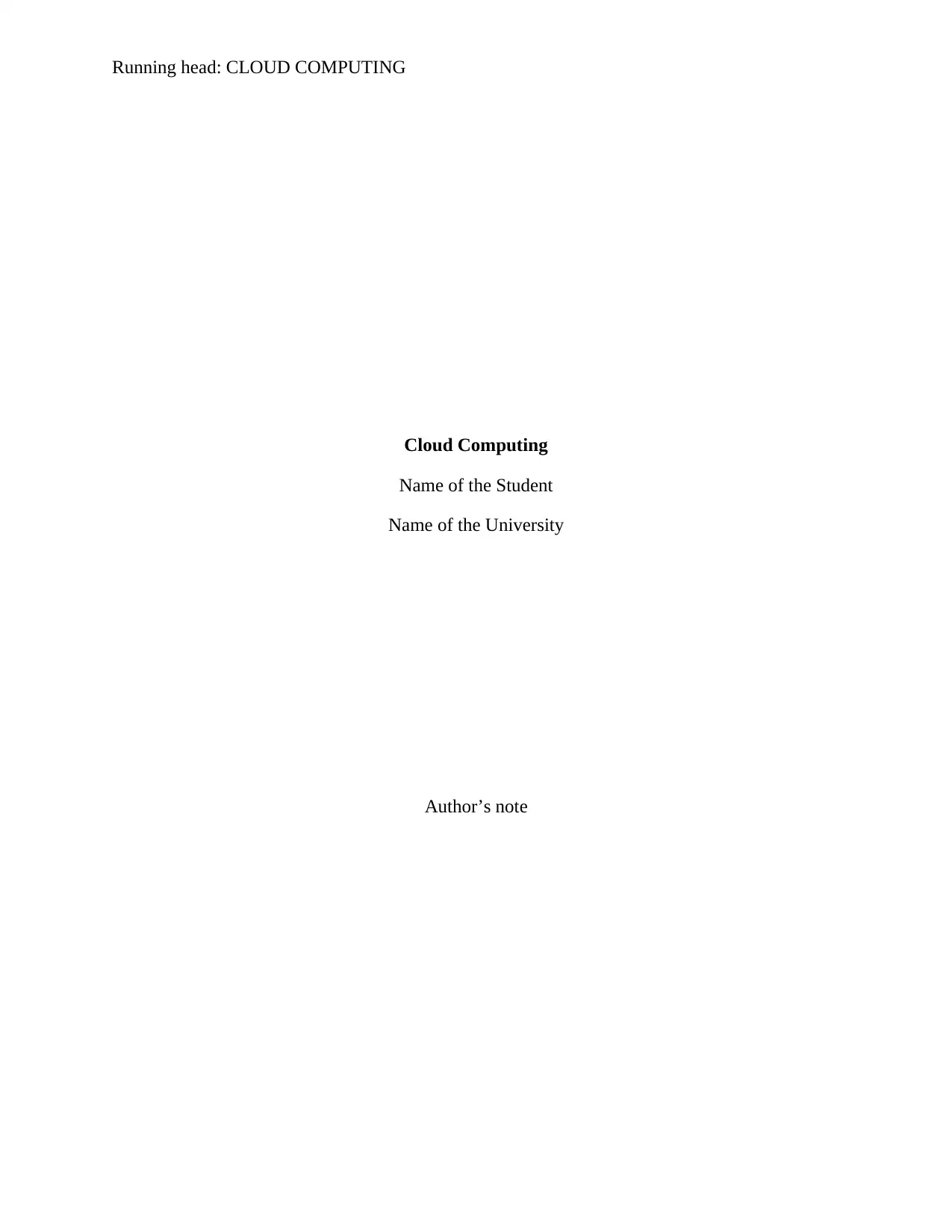
Running head: CLOUD COMPUTING
Cloud Computing
Name of the Student
Name of the University
Author’s note
Cloud Computing
Name of the Student
Name of the University
Author’s note
Paraphrase This Document
Need a fresh take? Get an instant paraphrase of this document with our AI Paraphraser

1
CLOUD COMPUTING
Table of Contents
Introduction......................................................................................................................................2
Cloud Computing.............................................................................................................................2
Advantages of Cloud Computing....................................................................................................3
Risks of Cloud Computing..............................................................................................................3
Conclusion.......................................................................................................................................4
References........................................................................................................................................5
CLOUD COMPUTING
Table of Contents
Introduction......................................................................................................................................2
Cloud Computing.............................................................................................................................2
Advantages of Cloud Computing....................................................................................................3
Risks of Cloud Computing..............................................................................................................3
Conclusion.......................................................................................................................................4
References........................................................................................................................................5
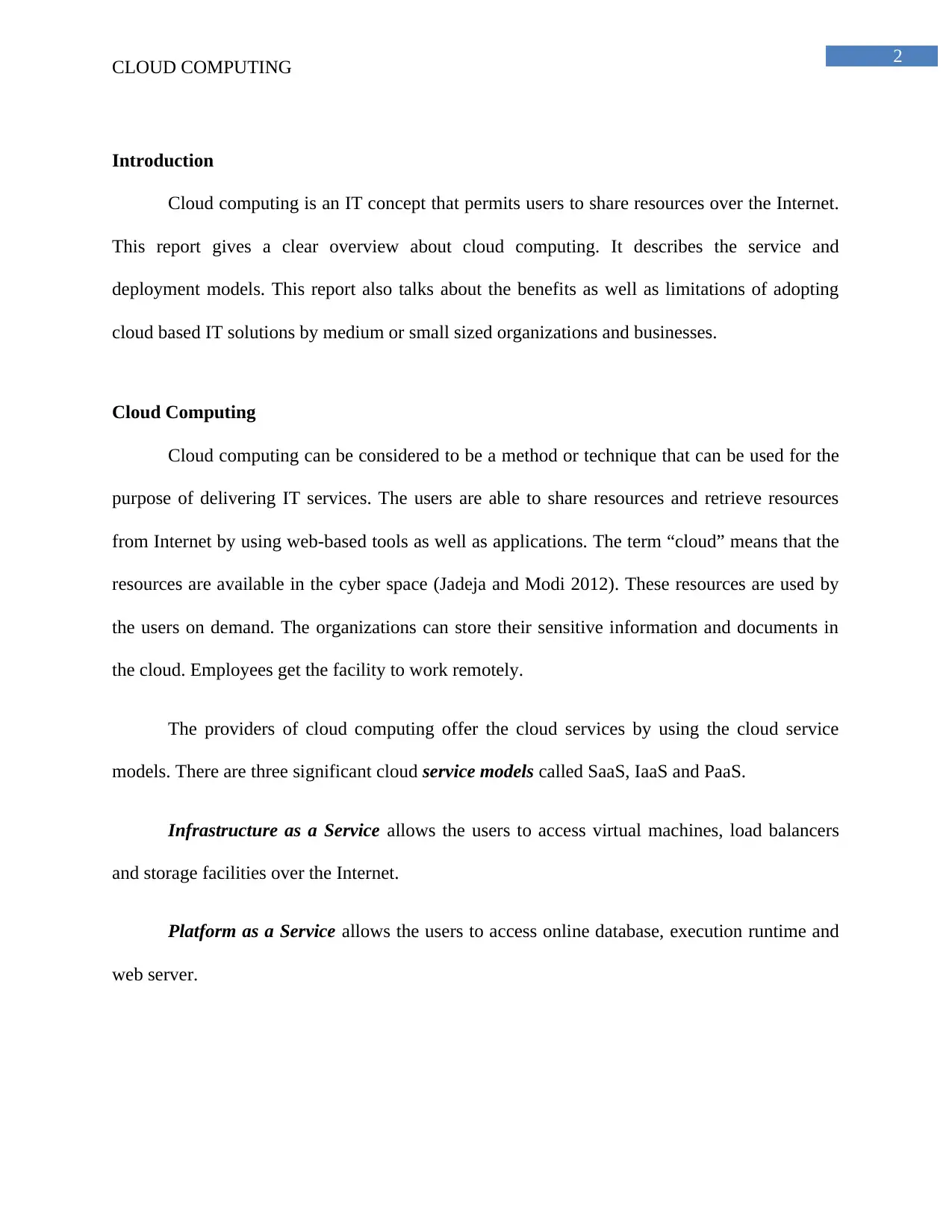
2
CLOUD COMPUTING
Introduction
Cloud computing is an IT concept that permits users to share resources over the Internet.
This report gives a clear overview about cloud computing. It describes the service and
deployment models. This report also talks about the benefits as well as limitations of adopting
cloud based IT solutions by medium or small sized organizations and businesses.
Cloud Computing
Cloud computing can be considered to be a method or technique that can be used for the
purpose of delivering IT services. The users are able to share resources and retrieve resources
from Internet by using web-based tools as well as applications. The term “cloud” means that the
resources are available in the cyber space (Jadeja and Modi 2012). These resources are used by
the users on demand. The organizations can store their sensitive information and documents in
the cloud. Employees get the facility to work remotely.
The providers of cloud computing offer the cloud services by using the cloud service
models. There are three significant cloud service models called SaaS, IaaS and PaaS.
Infrastructure as a Service allows the users to access virtual machines, load balancers
and storage facilities over the Internet.
Platform as a Service allows the users to access online database, execution runtime and
web server.
CLOUD COMPUTING
Introduction
Cloud computing is an IT concept that permits users to share resources over the Internet.
This report gives a clear overview about cloud computing. It describes the service and
deployment models. This report also talks about the benefits as well as limitations of adopting
cloud based IT solutions by medium or small sized organizations and businesses.
Cloud Computing
Cloud computing can be considered to be a method or technique that can be used for the
purpose of delivering IT services. The users are able to share resources and retrieve resources
from Internet by using web-based tools as well as applications. The term “cloud” means that the
resources are available in the cyber space (Jadeja and Modi 2012). These resources are used by
the users on demand. The organizations can store their sensitive information and documents in
the cloud. Employees get the facility to work remotely.
The providers of cloud computing offer the cloud services by using the cloud service
models. There are three significant cloud service models called SaaS, IaaS and PaaS.
Infrastructure as a Service allows the users to access virtual machines, load balancers
and storage facilities over the Internet.
Platform as a Service allows the users to access online database, execution runtime and
web server.
⊘ This is a preview!⊘
Do you want full access?
Subscribe today to unlock all pages.

Trusted by 1+ million students worldwide
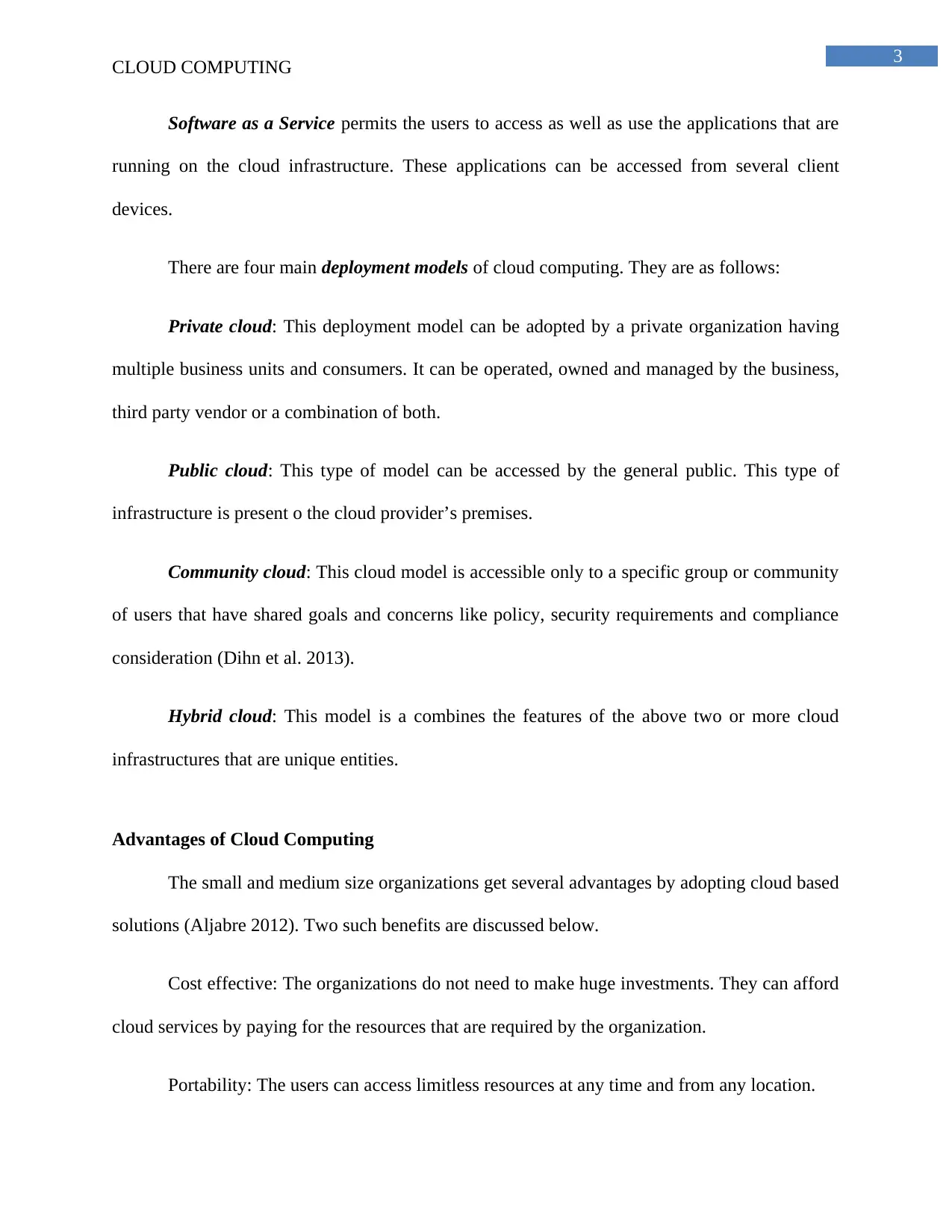
3
CLOUD COMPUTING
Software as a Service permits the users to access as well as use the applications that are
running on the cloud infrastructure. These applications can be accessed from several client
devices.
There are four main deployment models of cloud computing. They are as follows:
Private cloud: This deployment model can be adopted by a private organization having
multiple business units and consumers. It can be operated, owned and managed by the business,
third party vendor or a combination of both.
Public cloud: This type of model can be accessed by the general public. This type of
infrastructure is present o the cloud provider’s premises.
Community cloud: This cloud model is accessible only to a specific group or community
of users that have shared goals and concerns like policy, security requirements and compliance
consideration (Dihn et al. 2013).
Hybrid cloud: This model is a combines the features of the above two or more cloud
infrastructures that are unique entities.
Advantages of Cloud Computing
The small and medium size organizations get several advantages by adopting cloud based
solutions (Aljabre 2012). Two such benefits are discussed below.
Cost effective: The organizations do not need to make huge investments. They can afford
cloud services by paying for the resources that are required by the organization.
Portability: The users can access limitless resources at any time and from any location.
CLOUD COMPUTING
Software as a Service permits the users to access as well as use the applications that are
running on the cloud infrastructure. These applications can be accessed from several client
devices.
There are four main deployment models of cloud computing. They are as follows:
Private cloud: This deployment model can be adopted by a private organization having
multiple business units and consumers. It can be operated, owned and managed by the business,
third party vendor or a combination of both.
Public cloud: This type of model can be accessed by the general public. This type of
infrastructure is present o the cloud provider’s premises.
Community cloud: This cloud model is accessible only to a specific group or community
of users that have shared goals and concerns like policy, security requirements and compliance
consideration (Dihn et al. 2013).
Hybrid cloud: This model is a combines the features of the above two or more cloud
infrastructures that are unique entities.
Advantages of Cloud Computing
The small and medium size organizations get several advantages by adopting cloud based
solutions (Aljabre 2012). Two such benefits are discussed below.
Cost effective: The organizations do not need to make huge investments. They can afford
cloud services by paying for the resources that are required by the organization.
Portability: The users can access limitless resources at any time and from any location.
Paraphrase This Document
Need a fresh take? Get an instant paraphrase of this document with our AI Paraphraser
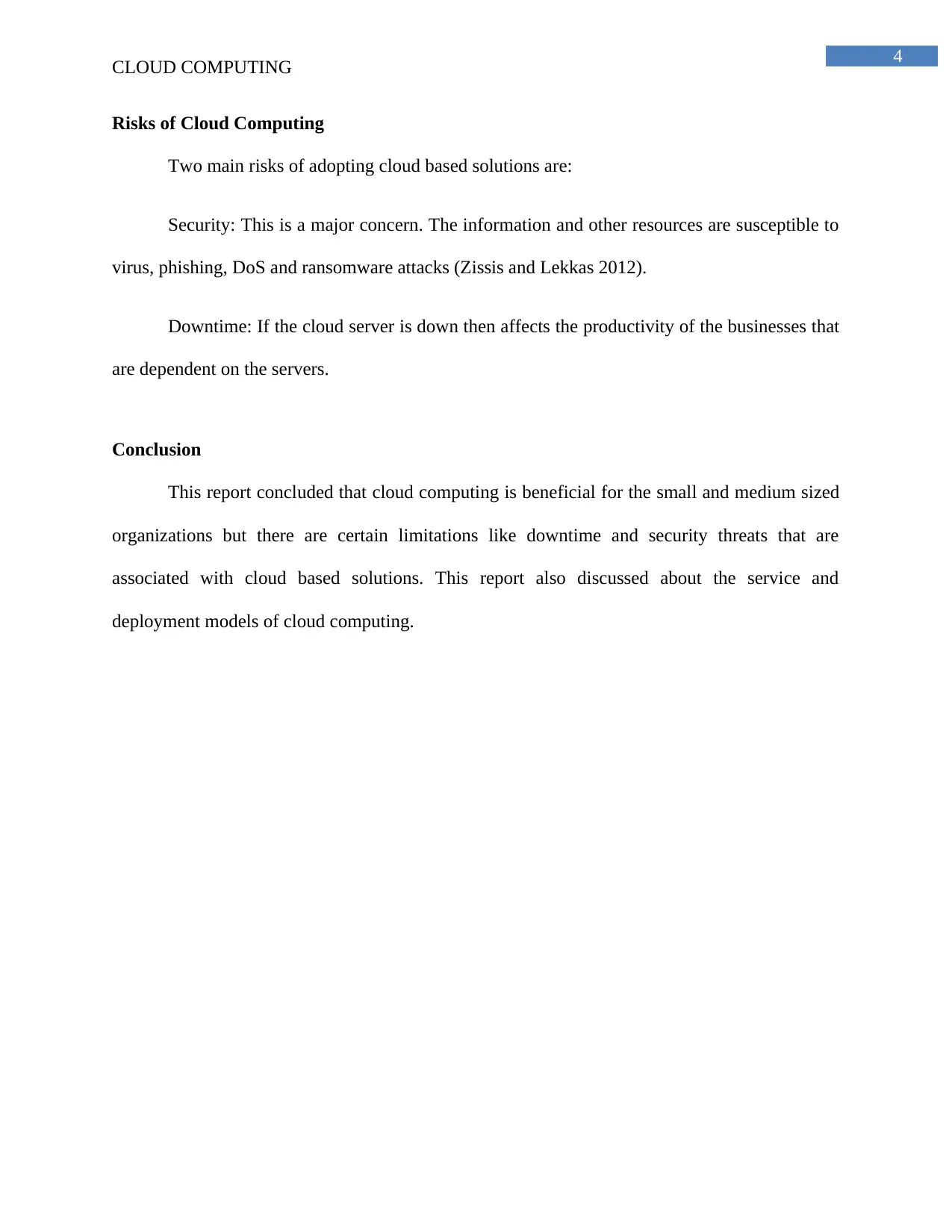
4
CLOUD COMPUTING
Risks of Cloud Computing
Two main risks of adopting cloud based solutions are:
Security: This is a major concern. The information and other resources are susceptible to
virus, phishing, DoS and ransomware attacks (Zissis and Lekkas 2012).
Downtime: If the cloud server is down then affects the productivity of the businesses that
are dependent on the servers.
Conclusion
This report concluded that cloud computing is beneficial for the small and medium sized
organizations but there are certain limitations like downtime and security threats that are
associated with cloud based solutions. This report also discussed about the service and
deployment models of cloud computing.
CLOUD COMPUTING
Risks of Cloud Computing
Two main risks of adopting cloud based solutions are:
Security: This is a major concern. The information and other resources are susceptible to
virus, phishing, DoS and ransomware attacks (Zissis and Lekkas 2012).
Downtime: If the cloud server is down then affects the productivity of the businesses that
are dependent on the servers.
Conclusion
This report concluded that cloud computing is beneficial for the small and medium sized
organizations but there are certain limitations like downtime and security threats that are
associated with cloud based solutions. This report also discussed about the service and
deployment models of cloud computing.
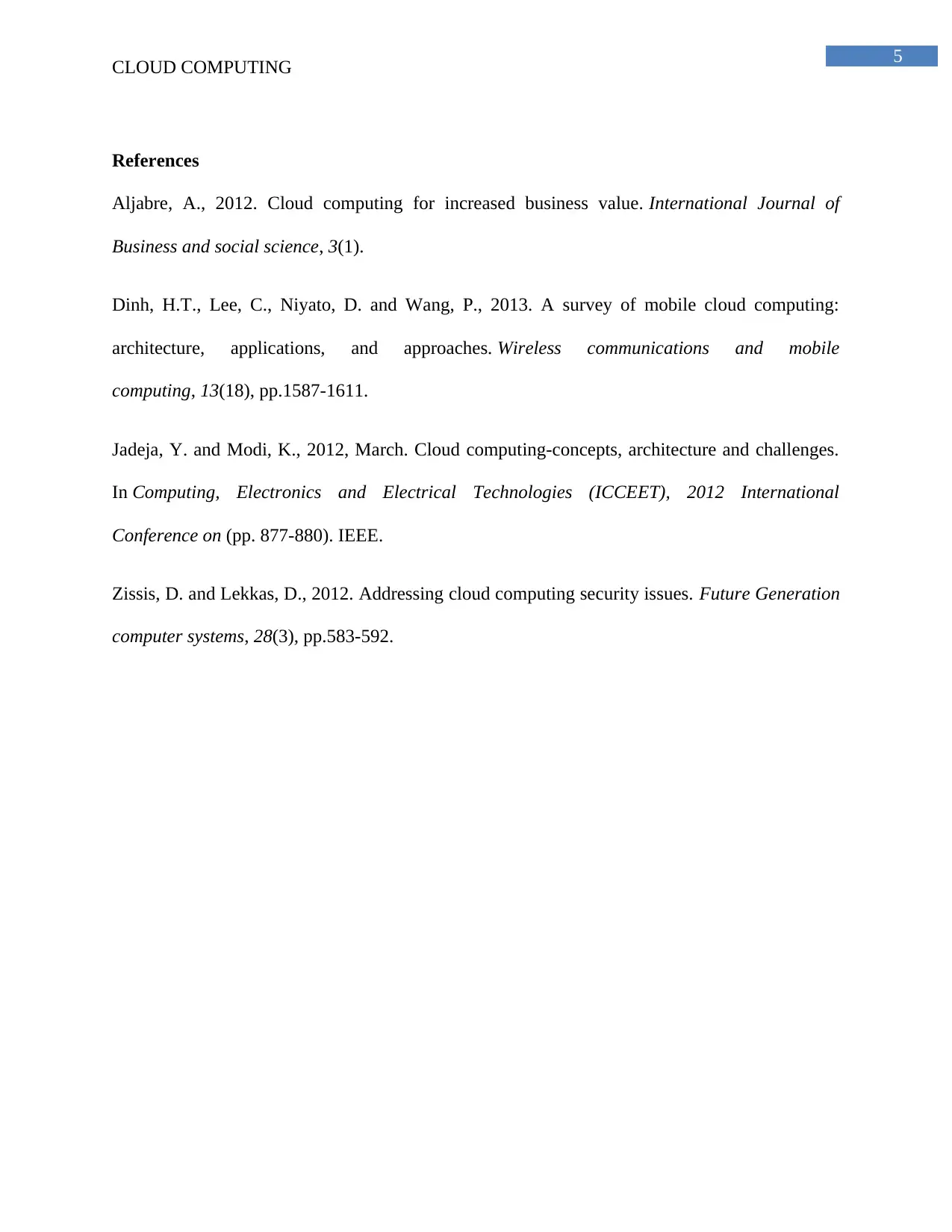
5
CLOUD COMPUTING
References
Aljabre, A., 2012. Cloud computing for increased business value. International Journal of
Business and social science, 3(1).
Dinh, H.T., Lee, C., Niyato, D. and Wang, P., 2013. A survey of mobile cloud computing:
architecture, applications, and approaches. Wireless communications and mobile
computing, 13(18), pp.1587-1611.
Jadeja, Y. and Modi, K., 2012, March. Cloud computing-concepts, architecture and challenges.
In Computing, Electronics and Electrical Technologies (ICCEET), 2012 International
Conference on (pp. 877-880). IEEE.
Zissis, D. and Lekkas, D., 2012. Addressing cloud computing security issues. Future Generation
computer systems, 28(3), pp.583-592.
CLOUD COMPUTING
References
Aljabre, A., 2012. Cloud computing for increased business value. International Journal of
Business and social science, 3(1).
Dinh, H.T., Lee, C., Niyato, D. and Wang, P., 2013. A survey of mobile cloud computing:
architecture, applications, and approaches. Wireless communications and mobile
computing, 13(18), pp.1587-1611.
Jadeja, Y. and Modi, K., 2012, March. Cloud computing-concepts, architecture and challenges.
In Computing, Electronics and Electrical Technologies (ICCEET), 2012 International
Conference on (pp. 877-880). IEEE.
Zissis, D. and Lekkas, D., 2012. Addressing cloud computing security issues. Future Generation
computer systems, 28(3), pp.583-592.
⊘ This is a preview!⊘
Do you want full access?
Subscribe today to unlock all pages.

Trusted by 1+ million students worldwide
1 out of 6
Related Documents
Your All-in-One AI-Powered Toolkit for Academic Success.
+13062052269
info@desklib.com
Available 24*7 on WhatsApp / Email
![[object Object]](/_next/static/media/star-bottom.7253800d.svg)
Unlock your academic potential
Copyright © 2020–2025 A2Z Services. All Rights Reserved. Developed and managed by ZUCOL.



